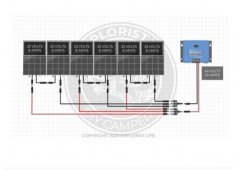It is a bit of a toss up depending on the actual shade.
I would tend to skip the fuses. Fairly low power and for some fault to occur just right to cause trouble would be exceedingly rare.
The reason I asked this is because of the windy nation wire ampacity chart shown.Length of wire doesn't matter for amperage rating. Amps heat a particular gauge of wire by some number of degrees.
Length matters for voltage drop. That may start to matter for 3 or 4 panels in parallel, but mostly I don't worry about it on PV side.
I care about voltage drop charge controller to battery, battery to inverter, AC wires inverter to load.
On a vehicle? Just size the PV wires to carry the current, without regard to length.
If wire length doesn’t matter regarding amperage,10AWG should be sufficient for inter-panel wiring? (~39 amps)
Or is 8AWG necessary for ~39 amps? (inter-panel wiring)
(these panels have 12AWG leads from the factory)
 (mine is a 24 volt system and the array makes 38.96 amps wired 4p2s)
(mine is a 24 volt system and the array makes 38.96 amps wired 4p2s)(pg. 12)
Last edited:




